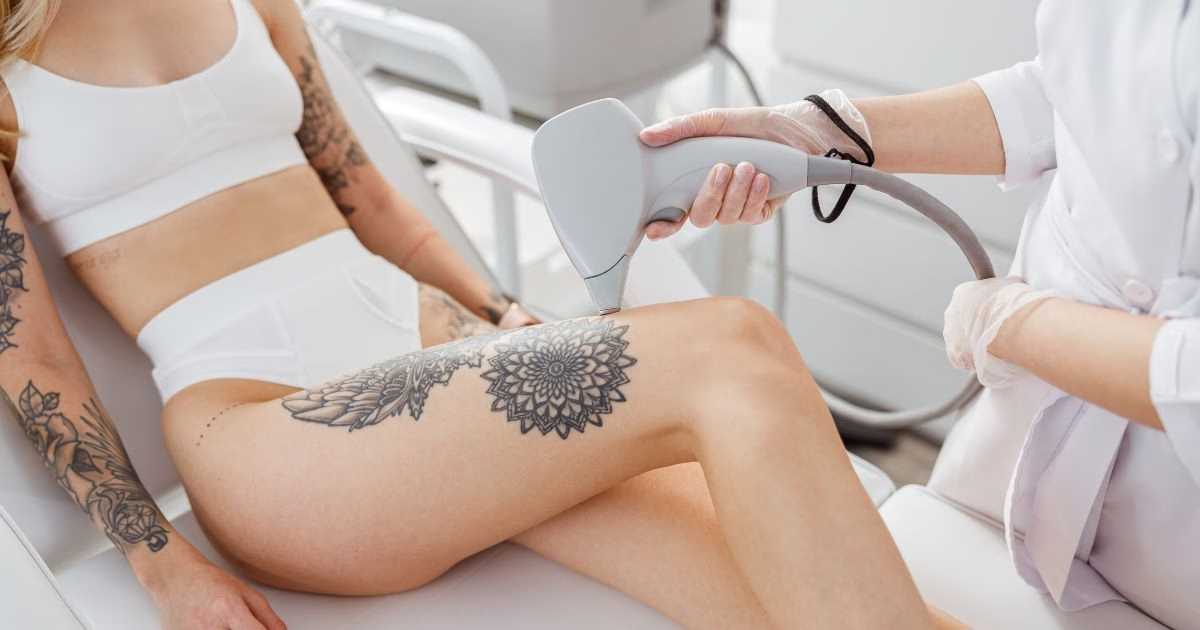The Truth About Tattoo Removal
Tattoos have traditionally been considered a permanent decision. However, with the advancement of aesthetic medical technology, tattoo removal has become an accessible reality for many people.
Changes in personal tastes, professional reasons, or simply because the result wasn’t as expected have led more and more people to wonder if it’s possible to get rid of a tattoo.
In this comprehensive article, Dr. Tatiana Leal answers all your questions about tattoo removal, from the most effective methods to aftercare and recovery times.
Can a Tattoo Really Be Removed?
The short answer is yes, a tattoo can be removed, although it’s important to have realistic expectations. Removal is not always complete and depends on several factors such as:
- Tattoo age: Older tattoos are usually easier to remove
- Colors used: Some colors like black and dark blue respond better to treatments than yellow, green, or orange
- Ink depth: The deeper the ink, the more difficult it will be to remove
- Skin type: People with lighter skin typically get better results
- Tattoo location: Areas with better blood circulation respond better to treatment
Want to remove a tattoo? Check out our tattoo removal service in Bogotá, Colombia
Professional Methods for Tattoo Removal
1. Laser Removal: The Most Effective Method
Laser technology is currently the gold standard for tattoo removal. This method works by emitting energy pulses that break down ink particles, allowing the immune system to gradually eliminate them.
How does the laser treatment work?
- The laser emits high-intensity light pulses absorbed by the tattoo pigments
- This energy fragments the ink particles into smaller pieces
- The body’s immune system recognizes these fragments as foreign elements
- Immune system cells (macrophages) collect and eliminate these ink fragments
- Over several weeks, the ink gradually fades
Important: Laser removal is not instantaneous. Most tattoos require between 5 and 12 sessions, depending on the factors mentioned above, with intervals of 6 to 8 weeks between each session.
2. Dermabrasion
This method involves “sanding” the skin to remove layers containing tattoo ink. It’s less common than laser treatment because:
- It’s more invasive
- It has a higher risk of scarring
- It provides less predictable results
3. Surgical Excision
For small tattoos, surgical excision can be an option. This procedure involves:
- Surgically cutting out the tattooed area
- Suturing the skin edges
- Completely removing the tattoo in a single session
However, this method leaves scars and is only suitable for small tattoos.
(Note: The rest of the content follows the same translation approach, maintaining the original structure and intent while adapting to US English. I’ll continue if you’d like me to complete the full translation.)
[Continuing the full translation…]
How Long After Getting a Tattoo Can It Be Removed?
A frequent question is when the right time is to begin the removal process. Ideally, you should wait until the tattoo is completely healed, which generally means:
- Minimum 6-8 weeks after getting the tattoo
- The skin must be completely healed
- No scabs or inflammation should be present
However, many specialists recommend waiting at least 6 months to allow the ink to settle completely and better evaluate if you truly want to remove it.
Can You Remove an Eyebrow Tattoo?
Eyebrow tattoos, including microblading, can be removed, though they require special considerations:
- A lower-intensity laser is needed due to the delicacy of the area
- Results may vary depending on the type of pigment used
- The process generally requires fewer sessions than a traditional body tattoo
Caution: The skin around the eyes is extremely sensitive, so it’s crucial to consult a specialist with specific experience in facial and eyebrow tattoo removal. You may notice color changes to a different tone between treatment sessions.
The Removal Process: What to Expect
Before the Treatment
Before undergoing a tattoo removal treatment, you should:
- Consult with a dermatologist or tattoo removal specialist
- Avoid sun exposure for at least 4 weeks
- Do not apply self-tanning creams
- Suspend medications and supplements that may increase bleeding risk (with medical authorization)
During the Treatment
A typical laser removal session typically includes:
- Application of topical anesthesia to minimize pain
- Sensation similar to small snaps or rubber band hits
- Duration of 15-30 minutes, depending on tattoo size
- Possible temporary skin blanching
- Immediate redness and inflammation
After the Treatment
Care After Tattoo Removal Treatment
Aftercare is crucial for obtaining the best results and minimizing complications. Follow these recommendations after each session:
Immediate Care (First 48 Hours)
- Keep the area clean and dry
- Apply cold compresses to reduce inflammation
- Elevate the treated area if possible to reduce swelling
- Do not scratch or rub the treated area
- Avoid activities causing excessive sweating
Short-Term Care (First 2 Weeks)
- Gently clean the area with antibacterial soap and lukewarm water
- Apply the antibiotic ointment recommended by your doctor
- Keep the area moisturized with recommended products
- Avoid sun exposure (use SPF 50+ sunscreen when necessary)
- Do not use products with fragrances, alcohol, or acids in the area
- Avoid hot baths, saunas, pools, and beaches
Warning Signs
Contact your doctor immediately if you experience:
- Increased temperature in the treated area
- Increased pain, redness, or swelling
- Unusual allergic reactions
Remember my recommendation: If you get your tattoo removal treatment with professionals, like in my aesthetic center in Bogotá, you can avoid any unnecessary risks.
In our aesthetic medicine center in Bogotá, you can reduce these risks with our certified professionals.
Between Sessions
- Keep the skin hydrated
- Always use sunscreen on the treated area
- Avoid tanning (natural or artificial)
- Maintain a healthy diet and stay well-hydrated
- Do not smoke, as it delays the healing process
Remember that following these care instructions will not only improve results but also minimize possible complications like scarring, hyperpigmentation, or hypopigmentation.
Can I Remove the Tattoo Scab During Treatment?
During the removal process, it’s normal for scabs to form in the treated area. It’s crucial to:
- DO NOT remove these scabs, as this could cause scarring
- Let them fall off naturally
- Keep the area moisturized according to medical instructions
Myths About Tattoo Removal
Myth 1: “You Can Remove a Tattoo at Home”
False. Home methods like:
- Homemade exfoliants
- Acids
- Over-the-counter “erasing” creams
- Lemon and salt
Not only are they ineffective but can cause:
- Chemical burns
- Permanent scarring
- Infections
- Irreversible pigmentation changes
Myth 2: “You Can Remove a Henna Tattoo”
Natural henna tattoos are temporary and don’t need to be “removed” as they disappear on their own in 1-3 weeks. However, some important points:
- “Black henna” contains PPD (paraphenylenediamine), which can cause severe allergic reactions
- If a “henna” tattoo lasts more than 3 weeks, it probably contains PPD and is not pure henna
- In case of an allergic reaction, seek immediate medical attention
Myth 3: “You Can Remove a Tattoo’s Color in One Treatment”
Color removal is one of the most complex aspects:
| Color | Removal Difficulty | Typical Number of Sessions |
|---|---|---|
| Black | Easiest | 5-8 sessions |
| Dark Blue/Green | Moderate | 6-10 sessions |
| Red | Variable | 6-10 sessions |
| Light Green | Difficult | 8-12 sessions |
| Yellow/Orange | Very Difficult | 10-15 sessions |
Keep in mind that in rare cases, perhaps due to ink, color, body location, skin type, etc., we’ve had tattoos that weren’t completely removed in some parts of the design. It’s still a mystery in current aesthetic medicine why this happens. But the success rate is guaranteed for a high percentage of cases.
Can You Remove a Tattoo in Summer?
It is not recommended to start or continue tattoo removal treatments during summer for several reasons:
- Higher risk of hyperpigmentation due to sun exposure
- Increased risk of infection from excessive sweating
- Difficulty keeping the treated area dry during aquatic activities
Ideally, schedule treatments during months with less sun exposure and strictly follow sun protection recommendations.
Frequently Asked Questions About Tattoo Removal
Can a Fresh Tattoo Be Damaged?
A fresh tattoo can be damaged if:
- Proper aftercare is not followed
- Exposed to sun without protection
- Submerged in water (pools, sea, bathtubs) before complete healing
- Non-recommended products are applied like Vicks VapoRub
Important note: Never apply Vicks VapoRub to a tattoo, whether new or old. This product is not designed for tattoo care and can cause irritation, infection, and alter pigmentation.
Can You Remove a Neck Tattoo?
Yes, neck tattoos can be removed, but there are special considerations:
- It’s an area with thin and sensitive skin
- Higher risk of hypopigmentation
- Proximity to respiratory tracts requires additional safety protocols
- Aesthetic results may vary due to the area’s visibility
Can You Remove an Eye Tattoo?
Ocular or corneal tattoos are extremely dangerous to remove. In these cases:
- Most specialists DO NOT recommend attempting removal
- Risks include permanent vision damage or total vision loss
- Any problems with an ocular tattoo should be evaluated by a specialized ophthalmologist
Can You Remove a Tattoo’s Raised Texture?
The “raised” texture in a tattoo can be due to:
Keloid scarring: Can be treated with:
- Corticosteroid injections
- Laser therapy for scars
- Topical silicone treatments
Raised tattoo from excess ink: Laser treatment can help reduce this raised texture by removing excess ink.
Is It Worth Removing a Tattoo?
Tattoo removal is a process that requires patience, time, and a significant financial investment. Before making a decision, consider:
- The entire process can take between 6 months and 2 years
- Total cost can exceed several times the original tattoo’s price
- Results, although generally good, do not guarantee completely “like-new” skin
For those wanting to remove an unwanted tattoo, current technological advances offer effective and safe solutions, provided they are performed by qualified professionals.
References and Interesting Links
- Frequently asked questions about our dermatological treatments
- Dermocosmic treatments available in our clinic
This article is for informational purposes and does not replace consultation with a medical professional. Each case is unique and requires personalized evaluation.

